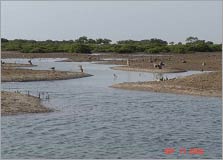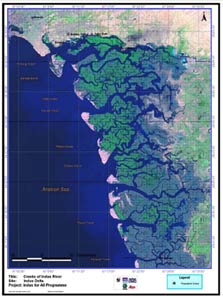Coastal Areas
The Sindh coastal region is located in the southeastern part of the country between the Indus border along the Sir Creek on the east, and the Hub River along the Balochistan coast on the west. This coastal region is about 350 km long and can be divided into the Indus Delta/Creek and Karachi coast.
The main vegetation found around the coastal areas are mangrove forests. Mangroves provide breeding ground for variety of fish, shrimps, crabs and other invertebrates and also are of great significance as a source of nutrients for fisheries. Since majority of the people residing near or around the coastal areas are engaged in fishing and related activities, mangroves make an important contribution to the local and national economy.
The most commonly distributed specie is Avicennia marina (Grey mangrove or Timar) that comprises 99% of the total vegetation.
The coastal wetlands attract a number of migratory birds, particularly waterfowl. Two species of turtles are also found in the shores of the Karachi coastline. These are the Green Turtle (Cheldnoia mydas) ad Olive Ridley Turtles (Lapidochely).
A major threat to the coastal biodiversity of Sindh is pollution. Untreated industrial effluents and agricultural run-off are the major sources of coastal and marine pollution. Effluents containing led, mercury and other heavy metals mainly from tanneries are most harmful to marine life, It is estimated that annually about 37,000 tonns of industrial waste is being dumped in the coastal environment of Karachi, whereas 20,000 tons of oil finds its way to beaches and harbours and the fishing grounds of Karachi annually.


